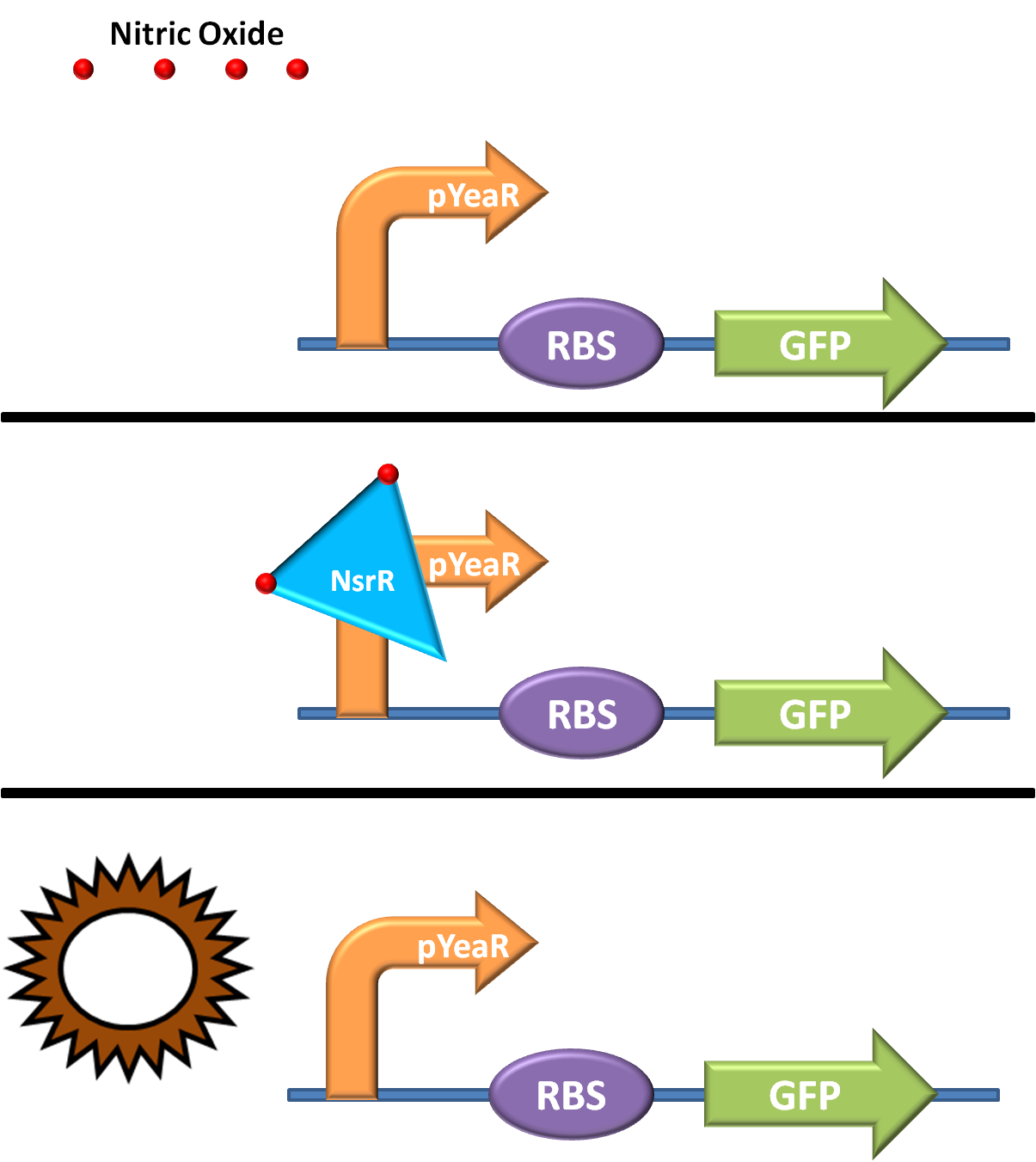Team:BCCS-Bristol/Wetlab/Part Design/Components/Promoters
From 2010.igem.org
m (→Promoters) |
(→How does it work?) |
||
| Line 8: | Line 8: | ||
===How does it work?=== | ===How does it work?=== | ||
| + | |||
| + | [[Image:Nsrr.png|thumbnail|left|400px|NsrR action is lifted by Nitric Oxide, allowing transcription]] | ||
| + | |||
A number of proteins interact with PyeaR in the cell, determining whether the genes behind it are expressed, but the most important is NsrR. | A number of proteins interact with PyeaR in the cell, determining whether the genes behind it are expressed, but the most important is NsrR. | ||
| Line 14: | Line 17: | ||
When Nitrates or Nitrites enter the cell they are converted to Nitric Oxide, which binds to NsrR causing it to dissociate from the PyeaR. As a result the promoter is no longer blocked and any genes downstream of PyeaR are then expressed - in our case the GFP reporter. | When Nitrates or Nitrites enter the cell they are converted to Nitric Oxide, which binds to NsrR causing it to dissociate from the PyeaR. As a result the promoter is no longer blocked and any genes downstream of PyeaR are then expressed - in our case the GFP reporter. | ||
| - | |||
| - | |||
===Why did we choose it?=== | ===Why did we choose it?=== | ||
Revision as of 15:28, 27 October 2010
iGEM 2010
Contents |
Promoters
Having considered several, the promoter we decided to use was PyeaR (BBa_216005), submitted by Edinburgh in 2009. It is around this biobrick that the entire project hinges, as it ensures a signal is only produced in the presence of Nitrates or Nitrites
How does it work?
A number of proteins interact with PyeaR in the cell, determining whether the genes behind it are expressed, but the most important is NsrR.
NsrR is a regulatory protein that blocks the transcription of a number of operons in E. coli, including those under the control of PyeaR. Under normal conditions NsrR binds to PyeaR preventing the transcription of any genes downstream of this promoter.
When Nitrates or Nitrites enter the cell they are converted to Nitric Oxide, which binds to NsrR causing it to dissociate from the PyeaR. As a result the promoter is no longer blocked and any genes downstream of PyeaR are then expressed - in our case the GFP reporter.
Why did we choose it?
There are several different Nitrate sensitive promoters that we could have used and we thought carefully before making our choice, however, PyeaR has several key advantages.
The first is that PyeaR is native to E. coli, meaning all the necessary proteins involved in its control (such as NsrR) are already in our chassis. This reduced the amount we would have to manipulate our bacteria, cutting down both on time and the number of factors that could potentially go wrong.
PyeaR is also advantageous because its action does not depend on the metabolic state of the E. coli. As most of the genes normally controlled by Nitrate sensitive promoters are involved in respiration in the absence of oxygen, most of these promoters can only be ‘switched on’ in an anaerobic environment. In contrast, PyeaR regulation works well in an aerobic environment, meaning we don’t have to worry about the metabolic state of our bacteria.
Finally, PyeaR was already available in the parts registry. This meant we could quickly pursue the more ambitious areas of our project, without getting held back having to develop new promoter biobricks.
Background
NsrR was first identified in Nitrosomonas europaea, a lithoautotropic bacterium. N. europaea is capable of acquiring free energy via the aerobic oxidation of ammonia to nitrite, as well as using nitrate and nitrite as alternative electron acceptors in an anaerobic environment. NsrR was reported as being a nitrite sensitive repressor of the nitrite reductase NirK, it is thought to protect N. europaea against the toxic affects of N O2 produced during nitrification [11]. There is also evidence from the human pathogen Neisseris meningitidis that NsrR reacts to nitric oxide [12].
NsrR is a member of the Rrf2 family of transcription factors, this is a family of transcription factors mostly involved in nitrate and iron metabolism, and nitric oxide detoxification. NsrR has been shown to regulate the response of E. coli to reactive nitrogen species [13], specifically to nitrite and nitric oxide [6], [14]. It regulates the response by both repressing and activating operons. Filenko et al. [13] reported 20 repressed genes and 24 activated genes.
The promoter that was used in conjunction with NsrR is from the yeaR-yoaG operon, PyeaR. This was identified by Filenko as a gene that is repressed by NsrR, though they also predicted that it was co-regulated by an oxygen responsive transcription factor Fnr. It was shown by Lin et al. [5] that its transcription is actually independent of this factor. This is important because the Fnr transcription factor is associated with E. coli ’s anaerobic metabolism, meaning that the metabolic state of the E. coli would have to be controlled if it were to act as a sensor. Using the PyeaR promoter avoids this restriction.
 "
"
